READER COMMENTS ON
"Brad Guest Hosts the 'Malloy Show' Friday!"
(11 Responses so far...)
COMMENT #1 [Permalink]
...
royeh
said on 7/9/2010 @ 6:21 pm PT...
Can't get into chat from bradblog.com
COMMENT #2 [Permalink]
...
gep2
said on 7/9/2010 @ 7:22 pm PT...
I wish Brad wouldn't misrepresent the real reason why I couldn't renew my podcast subscription
COMMENT #3 [Permalink]
...
mj
said on 7/9/2010 @ 7:59 pm PT...
pp.84-91 Proving Election Fraud "1988-2004 State Exit Poll Discrepancies" Charnin’s ‘simple math’ models are accompanied by sensitivity analysis tables that attend to any uncertainty in key assumptions, e.g,, 2008 Election Calculator base-case assumptions, estimated from “voter mortality tables, historical return-voter turnout percentages, Census votes cast, and 2008 National Exit Poll vote shares�� (p.203).
Readers nonetheless still skeptical of assumptions will appreciate an additional, alternative gem of analytical perspective on election fraud, one ‘from the bottom’ so to speak: Charnin does the extra legwork required to compare state exit poll results and state recorded vote-counts (only assumed correct, and aggregated into official ‘national’ vote-counts). Historical data consisting of 238 state exit polls in presidential elections 1988-2004 is drawn from the Evaluation of Edison-Mitofsky Election System 2004. (The same report with 2008 state exit poll data remains withheld by Fox News et al.) Charnin calculates and tabulates the discrepancy between vote-share margins of each state’s exit poll and corresponding vote-count, election-yearly, 2004 through 1988. Then, for an assumed state exit poll MoE of a realistic ±2% and a conservative ±3%, he tallies:
· the total number of ((exitpoll margin) – (votecount margin)) discrepancies ³ an assumed MoE
o the number of shifts in share-margin to the favor of the Democrat (i.e., in the vote-count)
o the number of shifts in share-margin to the favor of the Republican (i.e., in the vote-count)
The analysis involves mere simple subtractions and counting; no models or assumptions are used – possible only through the researcher’s commitment, insight and skill to ferret and extract unadjusted state exit poll data necessary for a simplest of math comparison with 238 state vote counts.
The findings are as stunning and compelling as the analysis is simple and direct (p.89). They point to an unsettling, pervasive trend in recorded state vote-counts favoring the ‘GOP’ almost exclusively. The tallies are broken down by margin of error, partisan shift, and state-groupings (15 Democratic, 15 Battleground, 21 Republican). Results: http://bit.ly/amsJiB
COMMENT #4 [Permalink]
...
mj
said on 7/9/2010 @ 8:03 pm PT...
COMMENT #5 [Permalink]
...
Tom Manaugh
said on 7/9/2010 @ 8:30 pm PT...
I have heard Gordon Peterson discuss his proposal in the past. Here are some of my thoughts about his proposal.
In general, I support the idea of using hand-counted paper ballots. That said, there are some advantages to using computers to avoid overvotes and unintended undervotes. Also, very long ballot can present daunting manpower challenges for counting votes in some voting districts.
Peterson's system could be an improvement on existing unauditable paperless computer-based systems. Basically, Peterson's proposal uses two independent computer systems: (a) a computer that can record and print a ballot that shows a voter's choices as well as tabulate and report vote totals and (b) a separate and unconnected computer that is able to read the printed ballots and then tabulate and report on the vote totals.
Comparing the totals that are independently reported by the two systems allows an automatic audit. If the two systems fail to agree or one or the other breaks down, printed ballots would still be available for hand counting.
Involving computers in elections is an invitation to fraud, but the above proposal would be less subject to fraudulent manipulation so long as the two computer systems were actually made to work strictly independently.
Comparing the totals of the recording and printing computer "a" with the totals of the tabulating and reporting computer "b" would serve as a check on accuracy of totals.
The ability of the voter to review and verify his or her printed ballot choices would serve as a check on the accuracy of recording and printing computer "a".
If the majority of voters are found to be unable or unwilling to verify thier votes (even when given properly clear and strong instructions to do so), that would be a good reason to favor hand-marked paper ballots over computer-printed paper ballots.
It is unfortunate that most voters, election officials, and politicians want to continue using computers in elections. If I were forced to choose existing computer-based systems with Peterson's proposed system, I would choose Peterson's. Otherwise, I hope that use of hand-marked and hand-counted paper ballots becomes the standard for all elections.
COMMENT #6 [Permalink]
...
Brad Friedman
said on 7/9/2010 @ 11:47 pm PT...
Gep2 (Gordon Peterson) - As you know, I did not "misrepresent the real reason why I couldn't renew [your] podcast subscription". In fact, I not only read your 4 page letter, almost completely, on air, but also allowed you to come on the show for another 45 mins thereafter to offer your point of view.
But for those who haven't heard the show tonight, the three reasons that Gordon gave in his email to Mike, explaining why he was canceling his podcast were: 1) Money (loss of business recently) 2) Mike's not supporting the Democratic Party enough and 3) Me as Mike's regular guest host, about which Gordon spent some 3 pages detailing his grievances, versus a paragraph or so on each of the first two.
You were treated way more than fairly, in every respect and I'd hope, at the very least, you'd renew your podcast subscription at this point, given what you received for having canceled it. But somehow, I suspect you won't. No matter, hopefully many others will make up for the loss of your contribution to progressive radio.
COMMENT #7 [Permalink]
...
Adam Fulford
said on 7/10/2010 @ 12:28 am PT...
Brad, you've got an awesome radio presence and delivery...except you should reduce your "uh" count.
COMMENT #8 [Permalink]
...
czaragorn
said on 7/10/2010 @ 11:11 am PT...
Great Bradcast (as always), Brad! Kudos on your calm, polite, deferent approach to the well-meaning Rube "Gordon" Goldberg. One of your commenters noted the turning of what should be the public service of elections into a profit-motivated business. I concur completely. I would like to also point out that, from a European perspective, the U$ has gone utterly mad with unregulated capitalism, to the point where most people will soon be unable to afford decent health care, decent education, decent nutrition - it goes on and on. Think about this: New Hampshire is not exceptional because it uses so many hand-marked, hand-counted paper ballots - at least not in the global scheme of things. In fact, the U$ is quite exceptional (the only other offender I can think of is India, and I suppose setting up precincts in Calcutta would intimidate many) in that its people refuse to adhere to the righteous system the U$ has imposed on many other countries: they all use hand-marked, hand-counted paper ballots. Works great, with the added advantage that those pesky exit polls don't need constant tweaking.
The only explanation is that there is a great deal of money to be made via the American system. Hades is too fine a destination for these miscreants.
Keep up the great work, Brother!
COMMENT #9 [Permalink]
...
Brad Friedman
said on 7/10/2010 @ 1:02 pm PT...
Thanks, Czaragorn! Glad we're reaching the Czech Republic loud and clear! Sorry the news from the homeland here hasn't gotten much better for ya, though!
COMMENT #10 [Permalink]
...
James F
said on 7/10/2010 @ 1:26 pm PT...
Hello!
I've been the lead poll worker at a Madison WI polling ward for the past 6 years and heard your discussion with Gordon Peterson about his 'electronic voting' system.
I'm pretty sure I understand what he's proposing although I'd like to see the full 4-page letter he wrote. It doesn't sound very different from the way we do voting in Madison WI --- For the most part we use optically scanned ballots the voter marks with a voting pen.
As per the Help America Vote Act we also have an ES&S 'Automark' ballot marking system intended for the disabled but free to use by anyone. (In the 4 years and 10 or so elections we've had this I'd say less than 10 voters have used it).
One of the primary differences in Peterson's method to our current method is he's recommending EVERYONE use terminals like the one we're using for disabled people.
In some ways I like his plan, however problems I see:
Expense --- these touch screen ballot marking systems are EXPENSIVE --- Wisconsin paid $5400 each for theirs. Ink cartridges are finicky and only last one or two elections at $70 each.
Finicky to set up --- As you experienced (and as I saw in one of your other blogs) ballots can be poorly marked by the machine --- one major problem is poor machine alignment. I do my best to align my polling ward's machine (both touch screen and printer) but I don't think many other polling wards put in the time and effort to do it right. Many of my poll working co-workers are intimidated by the machine and would have a hard time setting it up at all let alone aligning it.
Slower --- the touch screen system is slower than hand-marking ballots via pen even if you're familiar with it and know who you wish to vote for.
Bottlenecks --- If everyone has to use the touch-screen system then you're limited by the number of machines you have at the polling place. During the busiest times of the busiest elections at my polling ward I announced to voters that if they're willing they could forgo the added privacy of a voting booth and use one of the tables in the room to mark their ballots (our polling ward is in a school library). This allowed more than twice as many people to vote simultaneously and one result was that we had nobody waiting in line more than 30 minutes even in elections with over 80% voter turnout. --- Such an option isn't available if you're stuck with electronic ballot marking and don't have enough terminals. It's places like that where you hear reports of people waiting 3-5 hours in line to vote.
----
On the other hand I see problems with a pure hand-count. During one election we ran out of regular ballots and had to use photocopied ballots (that wouldn't fit in the tabulator) and thus those had to be hand-counted. We had about 200 photocopied ballots with about a dozen things to vote for --- thus 2400 things to tally. Checking and tallying them all took over two hours for merely 200 ballots. I'd hate to have to do that with 2000 ballots.
Is hand-counting more accurate? I think that's questionable. When the day goes late people get tired and could possibly mark a check in the wrong tally box. When we counted those 200 ballots I worried about this and if someone said they accidently were markng the wrong box for a while there'd be no way to fix it short of a full recount. You'd pretty much have to hand-count the ballots twice to ensure there were no mistakes like this.
There's also an issue with poorly marked ballots being questionable due to voters being sloppy. I've had to reject too many votes (especially absentee ballots) because we weren't able to determine the voter's intent.
I saw pictures of the LA ballot and like the punch-card systems that were the bane of the Florida 2000 election the design is absolutely horrible. Madison WI's ballots are often LARGE 11×17 card stock paper. You don't have those flip book things and you don't end up with a ballot full of tightly packed nameless dots, dimples or chads. Ballots are human-readable and look more like this:
=== ===> Candidate A
=== ===> Candidate B
=== ===> Write In __________-
Vote by filling in the open portion of the arrow with the ballot pen like this:
=== ===> Candidate A
===####===> Candidate B
=== ===> Write In __________-
It's simple, easy to read, easy to verify, and difficult to screw up (although I've seen it happen). I haven't heard of any complaints about this system in general and am surprised more places don't adopt it it.
COMMENT #11 [Permalink]
...
Brad Friedman
said on 7/10/2010 @ 6:58 pm PT...
James F -
I'll just respond to a few of your comments above...
On the other hand I see problems with a pure hand-count. During one election we ran out of regular ballots and had to use photocopied ballots (that wouldn't fit in the tabulator) and thus those had to be hand-counted. We had about 200 photocopied ballots with about a dozen things to vote for --- thus 2400 things to tally. Checking and tallying them all took over two hours for merely 200 ballots. I'd hate to have to do that with 2000 ballots.
You wouldn't. There's no reason to have more than 500 voters at each precinct and thus, likely far fewer ballots to count. (And much shorter lines for voting, btw, for busy elections!)
No precinct would ever have to count 2000 ballots. Or, if for some reason they did, that just means you need more counting teams.
Is hand-counting more accurate? I think that's questionable. When the day goes late people get tired and could possibly mark a check in the wrong tally box. When we counted those 200 ballots I worried about this and if someone said they accidently were markng the wrong box for a while there'd be no way to fix it short of a full recount. You'd pretty much have to hand-count the ballots twice to ensure there were no mistakes like this.
I'm guessing that the counting team in the instance above was the same pollworking team that had been at the polls already for the impossibly long day? In the case of hand-counting done properly, a fresh team of counters come in when the polls close (and it's much easier to get them too, since it's after a regular business day!)
Evidence from various elections shows that hand-counting is MORE accurate than the machines, not less. Still, I'm not calling for hand-counting. I'm calling for hand-count pilot programs to determine the feasibility for it, gather data, etc. Unlike the voting machine companies, I don't feel like saying "Trust me! It'll work perfectly! Implement my system without bothering to gather data on it first or do appropriate due-diligence!"
That said, evidence from places that already do hand-counts seem to suggest that it works very well and is both as accurate and fast (if not more so, on both) than op-scan counting.
There's also an issue with poorly marked ballots being questionable due to voters being sloppy. I've had to reject too many votes (especially absentee ballots) because we weren't able to determine the voter's intent.
That issue is as relevant with hand-marked op-scan as it is with hand-marked, hand-counted ballots.
On the other hand, when you're counting such ballots, you actually KNOW that you're looking at the voter's intent, which you can NEVER know with machine-marked ballots. (Gordon liked to call them "verified" ballots, but what he more accurately meant was "verifiable" ballots, since there's no way to know they were ACTUALLY verified as accurate.)
As to ambiguously marked ballots, well, voters have to have responsibility to mark them accurately and as unambiguously as possible. As we saw in the MN Franken/Coleman race, determining voter intent on 3 million ballots was not particularly difficult, with all but just 11 or 12 ballots --- out of 3 million --- being unanimously agreed upon by all political parties.
 It's my final night this week guest hosting the nationally syndicated Mike Malloy Show. Mike will be back Monday, but until then, we'll be BradCasting our last show for a while again LIVE from L.A.'s KTLK am1150 9pm-Midnight ET (6p-9p PT). It's your last chance for a while to join us by tuning in, chatting in, Tweeting in and calling in!
It's my final night this week guest hosting the nationally syndicated Mike Malloy Show. Mike will be back Monday, but until then, we'll be BradCasting our last show for a while again LIVE from L.A.'s KTLK am1150 9pm-Midnight ET (6p-9p PT). It's your last chance for a while to join us by tuning in, chatting in, Tweeting in and calling in!

 Appeals Court Blocks Last Route for Voters to Challenge Violations of the VRA: 'BradCast' 5/19/25
Appeals Court Blocks Last Route for Voters to Challenge Violations of the VRA: 'BradCast' 5/19/25 Sunday 'Now Hoarding' Toons
Sunday 'Now Hoarding' Toons Mad World:
Mad World: 'Green News Report' 5/15/25
'Green News Report' 5/15/25
 Plane Corruption and the Future of the DOJ: 'BradCast' 5/14/25
Plane Corruption and the Future of the DOJ: 'BradCast' 5/14/25 'Deeply Evil': GOP Proposes Largest Medicaid Cuts in History: 'BradCast' 5/13/25
'Deeply Evil': GOP Proposes Largest Medicaid Cuts in History: 'BradCast' 5/13/25 'Green News Report' 5/13/25
'Green News Report' 5/13/25 And Then They Came for the Mayors...: 'BradCast' 5/12/25
And Then They Came for the Mayors...: 'BradCast' 5/12/25 Sunday 'New Guy, Old Guy' Toons
Sunday 'New Guy, Old Guy' Toons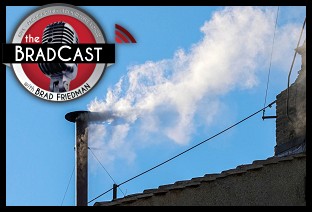 Blowing Smoke. At the Vatican and White House: 'BradCast' 5/8/25
Blowing Smoke. At the Vatican and White House: 'BradCast' 5/8/25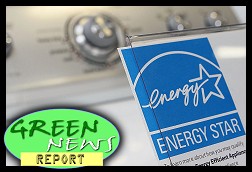 'Green News Report' 5/8/25
'Green News Report' 5/8/25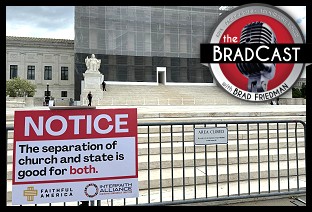 SCOTUS Weighs Public Funding of Religious Schools: 'BradCast' 5/7/25
SCOTUS Weighs Public Funding of Religious Schools: 'BradCast' 5/7/25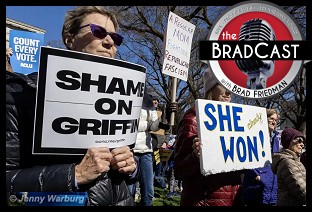 Trump Judge Blocks NC GOP Theft of 2024 Supreme Court Seat: 'BradCast' 5/6/25
Trump Judge Blocks NC GOP Theft of 2024 Supreme Court Seat: 'BradCast' 5/6/25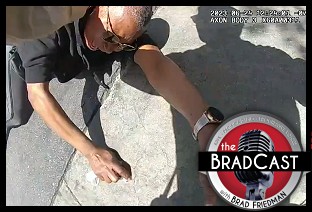 Prosecutors Quit After U.S Attny Strikes Deal With Felon Cop: 'BradCast' 5/5/25
Prosecutors Quit After U.S Attny Strikes Deal With Felon Cop: 'BradCast' 5/5/25 Trump Losing Streak Continues into SECOND Hundred Days: 'BradCast' 5/1/25
Trump Losing Streak Continues into SECOND Hundred Days: 'BradCast' 5/1/25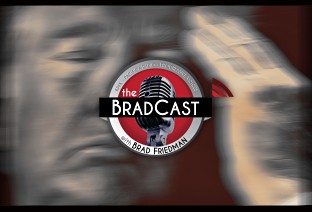 100 Daze (w/ Digby and Driftglass): 'BradCast' 4/30/25
100 Daze (w/ Digby and Driftglass): 'BradCast' 4/30/25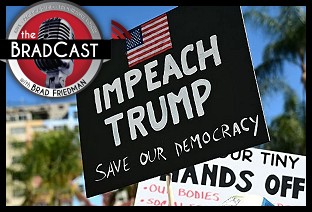 Campaign to 'Impeach Trump Again' Gains Fresh Momentum: 'BradCast' 4/29/25
Campaign to 'Impeach Trump Again' Gains Fresh Momentum: 'BradCast' 4/29/25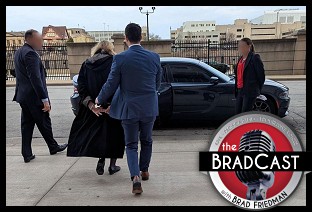 And Then They Came for the Judges...: 'BradCast' 4/28/25
And Then They Came for the Judges...: 'BradCast' 4/28/25 Trump EPA Guts Enviro Justice Office: 'BradCast' 4/24/25
Trump EPA Guts Enviro Justice Office: 'BradCast' 4/24/25
 VA GOP VOTER REG FRAUDSTER OFF HOOK
VA GOP VOTER REG FRAUDSTER OFF HOOK Criminal GOP Voter Registration Fraud Probe Expanding in VA
Criminal GOP Voter Registration Fraud Probe Expanding in VA DOJ PROBE SOUGHT AFTER VA ARREST
DOJ PROBE SOUGHT AFTER VA ARREST Arrest in VA: GOP Voter Reg Scandal Widens
Arrest in VA: GOP Voter Reg Scandal Widens ALL TOGETHER: ROVE, SPROUL, KOCHS, RNC
ALL TOGETHER: ROVE, SPROUL, KOCHS, RNC LATimes: RNC's 'Fired' Sproul Working for Repubs in 'as Many as 30 States'
LATimes: RNC's 'Fired' Sproul Working for Repubs in 'as Many as 30 States' 'Fired' Sproul Group 'Cloned', Still Working for Republicans in At Least 10 States
'Fired' Sproul Group 'Cloned', Still Working for Republicans in At Least 10 States FINALLY: FOX ON GOP REG FRAUD SCANDAL
FINALLY: FOX ON GOP REG FRAUD SCANDAL COLORADO FOLLOWS FLORIDA WITH GOP CRIMINAL INVESTIGATION
COLORADO FOLLOWS FLORIDA WITH GOP CRIMINAL INVESTIGATION CRIMINAL PROBE LAUNCHED INTO GOP VOTER REGISTRATION FRAUD SCANDAL IN FL
CRIMINAL PROBE LAUNCHED INTO GOP VOTER REGISTRATION FRAUD SCANDAL IN FL Brad Breaks PA Photo ID & GOP Registration Fraud Scandal News on Hartmann TV
Brad Breaks PA Photo ID & GOP Registration Fraud Scandal News on Hartmann TV  CAUGHT ON TAPE: COORDINATED NATIONWIDE GOP VOTER REG SCAM
CAUGHT ON TAPE: COORDINATED NATIONWIDE GOP VOTER REG SCAM CRIMINAL ELECTION FRAUD COMPLAINT FILED AGAINST GOP 'FRAUD' FIRM
CRIMINAL ELECTION FRAUD COMPLAINT FILED AGAINST GOP 'FRAUD' FIRM RICK SCOTT GETS ROLLED IN GOP REGISTRATION FRAUD SCANDAL
RICK SCOTT GETS ROLLED IN GOP REGISTRATION FRAUD SCANDAL VIDEO: Brad Breaks GOP Reg Fraud Scandal on Hartmann TV
VIDEO: Brad Breaks GOP Reg Fraud Scandal on Hartmann TV RNC FIRES NATIONAL VOTER REGISTRATION FIRM FOR FRAUD
RNC FIRES NATIONAL VOTER REGISTRATION FIRM FOR FRAUD EXCLUSIVE: Intvw w/ FL Official Who First Discovered GOP Reg Fraud
EXCLUSIVE: Intvw w/ FL Official Who First Discovered GOP Reg Fraud GOP REGISTRATION FRAUD FOUND IN FL
GOP REGISTRATION FRAUD FOUND IN FL

































